7+ Communication Plan for Employees Examples
A comprehensive “Communication Plan for Employees” serves as the backbone of any thriving organization. This guide delves deep into effective communication examples, offering a rich array of strategies and insights. It’s tailored to enhance internal dialogue, ensuring clarity and cohesion across all levels. Discover how a well-crafted plan can revolutionize your team dynamics, boost morale, and streamline operations. By implementing these proven communication examples, you’ll foster a more engaged and productive workforce, paving the way for success.
Download Communication Plan for Employees Bundle
Communication Plan for Employees
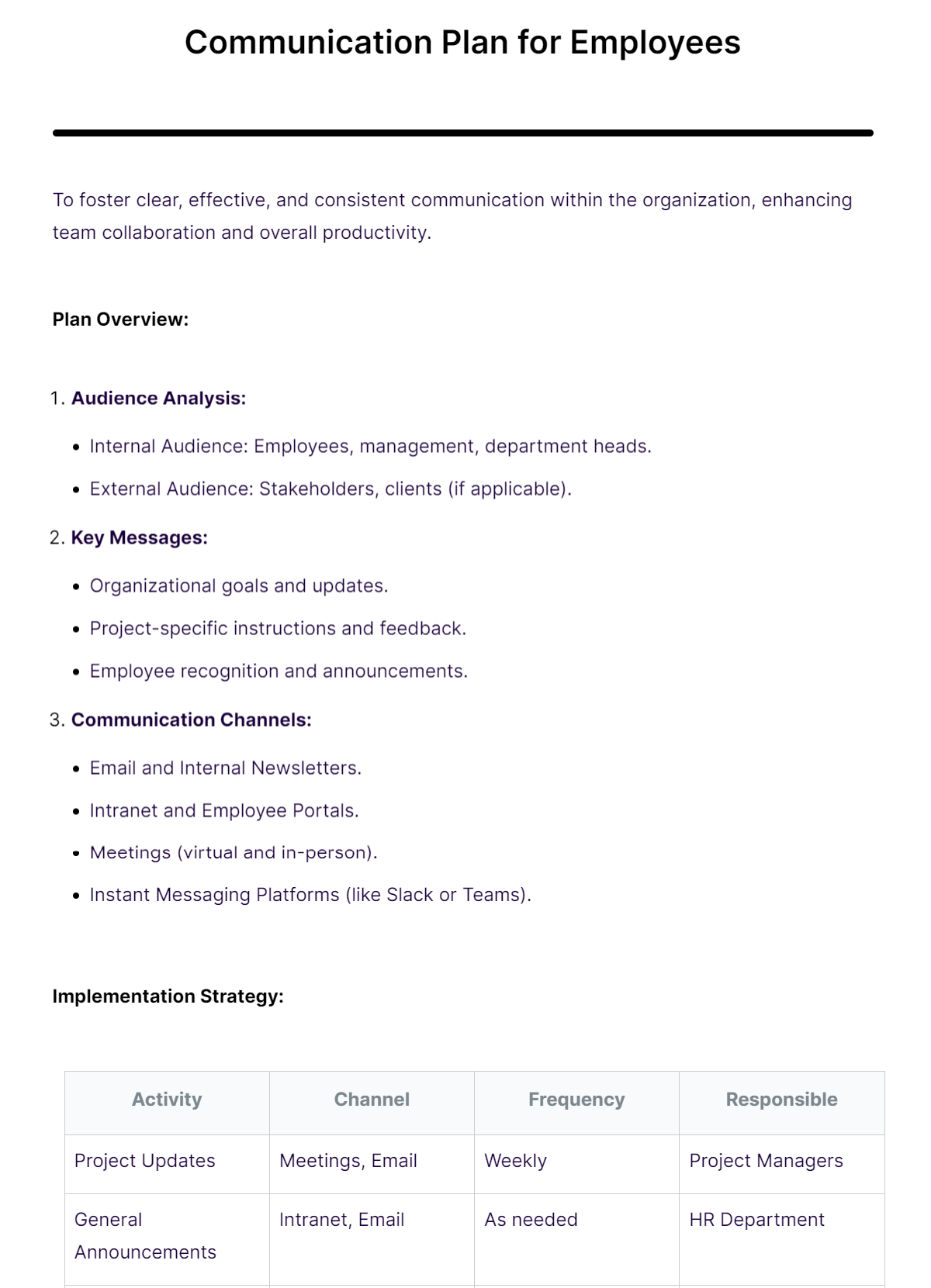
The “Communication Plan for Employees”is a comprehensive guide designed to enhance team collaboration and productivity within an organization. It offers a structured approach with audience analysis, key messages, various communication channels, and an implementation strategy. The plan also includes regular evaluation and feedback mechanisms, emergency communication plan protocols, and annual reviews, supported by practical tools like templates and communication calendars. This guide is an essential resource for any organization looking to improve internal communication and foster a productive work environment
Internal Communication Plan for Employees
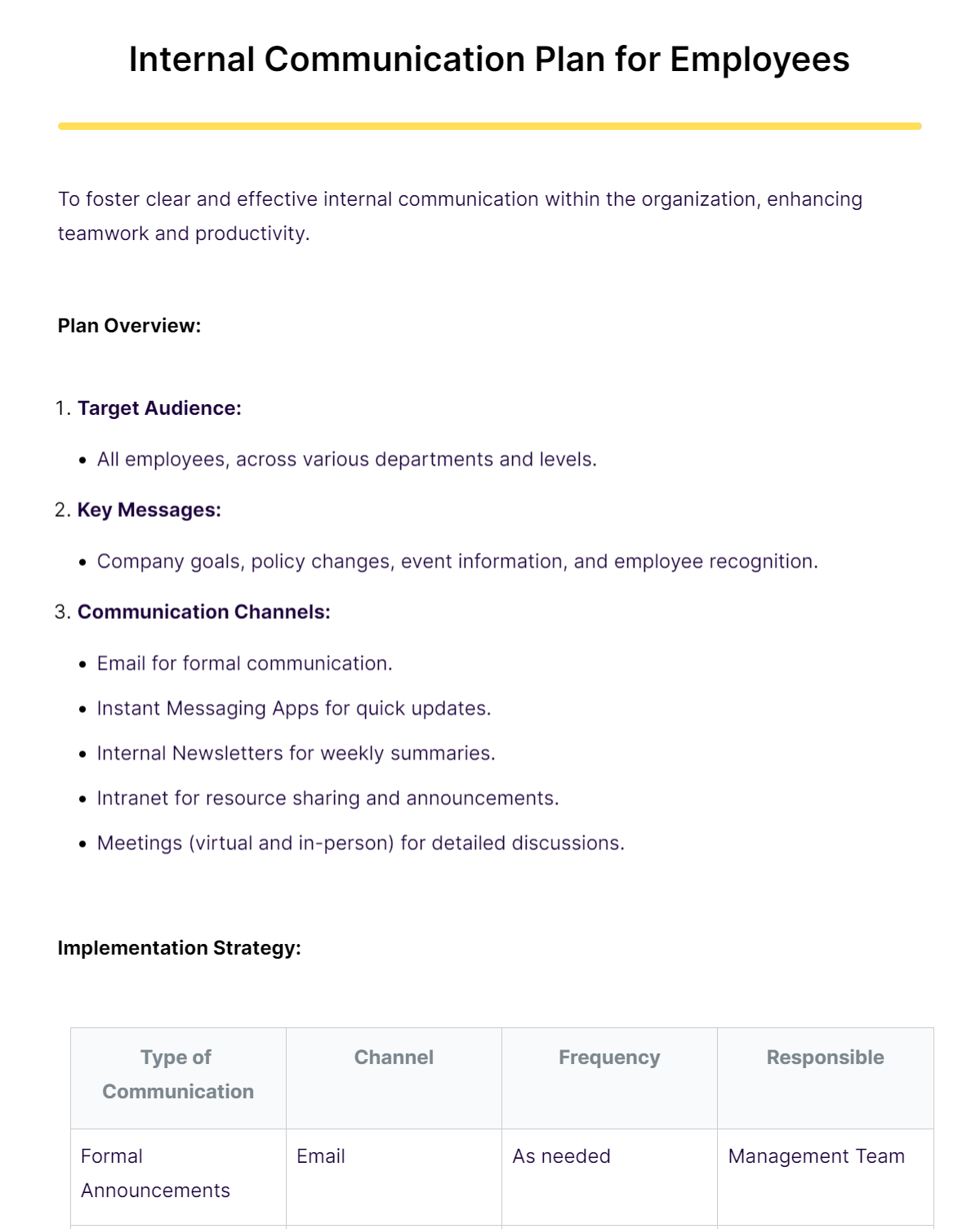
The document “Internal Communication Plan for Employees” is a structured approach for enhancing internal communication within organizations. It emphasizes the importance of clear and effective communication for improving teamwork and productivity. The plan includes targeting all employees across various departments and levels, key messages about company goals, policy changes, and employee recognition. It outlines diverse communication channels like email, instant messaging apps, internal newsletters, intranet, and meetings. The plan also covers implementation strategies, feedback mechanisms, training and support, evaluation methods, visual aids, and supporting documents, ensuring seamless, efficient, and effective internal communication plan within the organization
Hazard Communication Plan for Employees
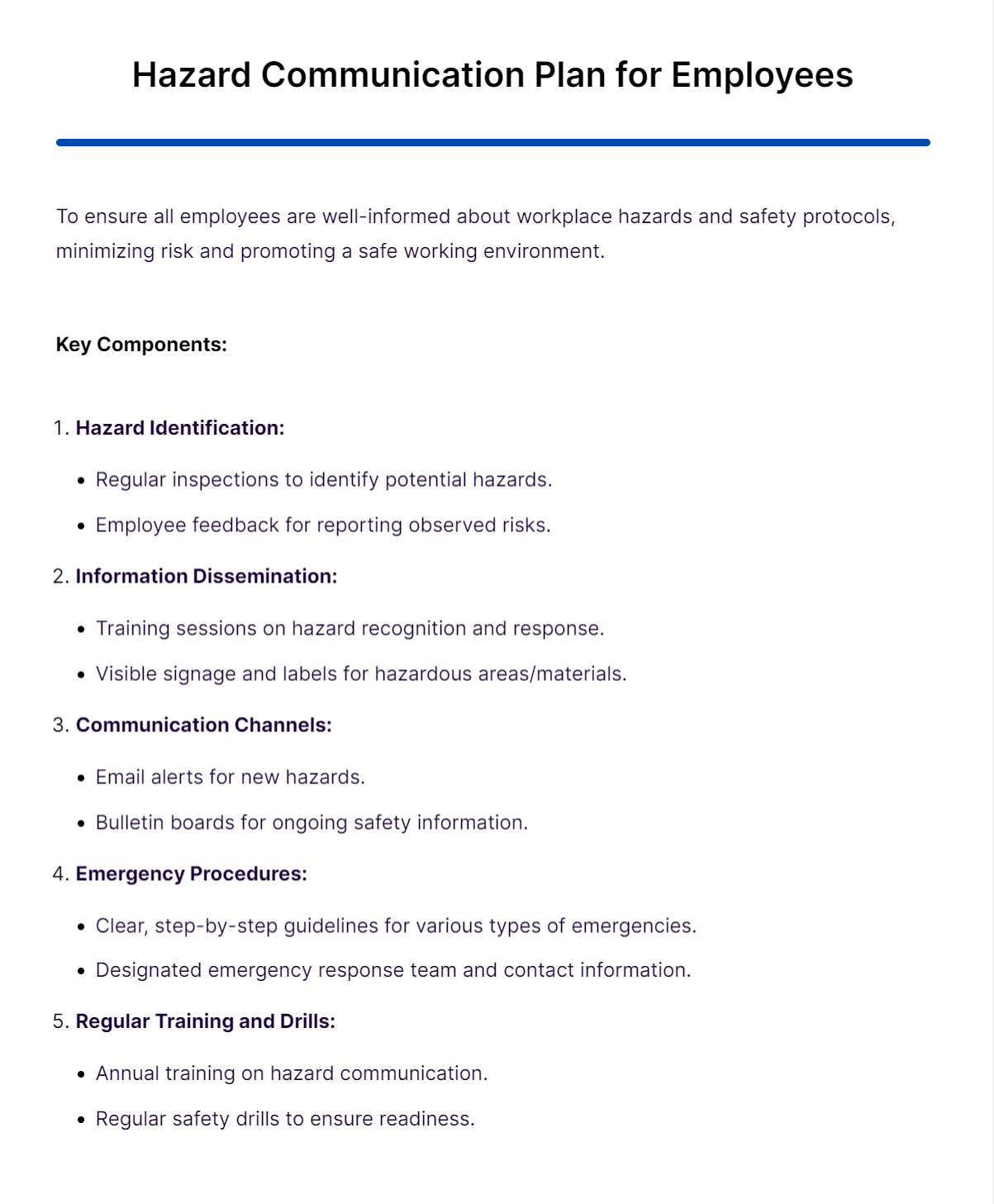
The Hazard Communication Plan for Employees comprehensive guide to ensure workplace safety by informing employees about hazards and safety protocols. It covers key components like hazard identification, information dissemination, communication channels, emergency procedures, and regular training and drills. The plan also outlines an implementation strategy, documentation practices, evaluation and feedback mechanisms, and visual aids to support understanding. It’s designed to be straightforward, comprehensive, and ready for immediate implementation, emphasizing regular updates and active employee involvement.
Employee Survey Communication Plan

The Employee Survey Communication Plan is a provides a systematic approach to conducting surveys for honest feedback and employee engagement enhancement. It includes pre-survey communication, survey launch, mid-survey check-ins, post-survey communication, and results sharing, all aimed at identifying areas for improvement. The plan emphasizes clear messaging, regular updates, and visual aids like graphs and charts to track participation and evaluate communication effectiveness.
IT Employee Communication Plan Template
Employee Transition Communication Plan Template
Employees Internal Communications Strategy template

intranetconnections.com
DownloadCommunication Plan for Employees Checklist
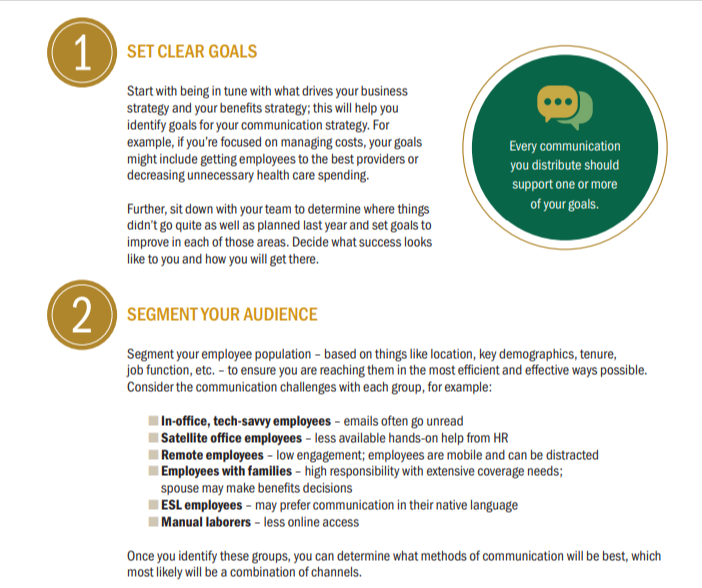
cbiz.com
DownloadWays To Build An Effective Employee Communication Plan
An effective Employee Communication Plan ensures a well-informed, engaged, and cohesive workforce. It’s crucial for establishing a shared understanding and achieving organizational goals. By integrating strategic methodologies and considering the diverse communication needs of your employees, you can develop a plan that promotes transparency, productivity, and a positive work culture.
- Regular Team Meetings: Schedule weekly or bi-weekly meetings to discuss ongoing projects and address concerns.
Let’s gather to align our goals and share updates every Monday morning.
- Employee Surveys: Conduct surveys to gather feedback on workplace satisfaction and communication effectiveness.
Your input is valuable; please fill out this survey to help us improve our communication.
- Email Newsletters: Send out a monthly newsletter to keep employees informed about company news and achievements.
Check out our latest newsletter for important updates and employee spotlights!
- Suggestion Box: Encourage open communication by allowing employees to anonymously submit suggestions and ideas.
Feel free to drop your suggestions in the box; every idea is welcome!
- Training Sessions: Offer regular training to help employees improve their communication skills and understand the plan.
Join our communication skills workshop to enhance your team collaboration.
- Digital Notice Boards: Utilize digital boards for instant updates and reminders.
Keep an eye on the digital board for the latest news and updates.
- One-on-One Check-ins: Personal meetings between managers and employees to discuss progress and concerns.
Let’s schedule a check-in to discuss your progress and any support you might need.
- Collaborative Tools: Implement tools like Slack or Teams for easy day-to-day communication and project coordination.
Please update the team on your project status in our Slack channel.
- Feedback Culture: Promote a culture where constructive feedback is encouraged and valued.
We appreciate your feedback; let’s discuss how we can implement your suggestions.
- Transparent Leadership: Ensure leaders communicate openly about changes and decisions.
We want to be transparent about the upcoming changes and how they will affect you
How to Write Communication Plan for Employees?
Writing a comprehensive Communication Plan for Employees involves strategic planning and clear objectives to ensure effective internal communication.
- Define Objectives: Establish what you aim to achieve with the communication plan, like improved transparency or enhanced team collaboration.
- Identify the Audience: Understand your employees’ roles, departments, and communication needs.
- Develop Key Messages: Tailor messages that resonate with your employees, focusing on clarity and relevance to their roles.
- Choose Appropriate Channels: Select the most effective communication tools, whether it’s email, internal newsletters, or team meetings.
- Set a Timeline: Define the frequency of communications, like weekly updates or monthly newsletters.
- Assign Responsibilities: Designate team members to handle different aspects of communication, ensuring accountability.
- Establish Feedback Mechanisms: Incorporate systems for employees to provide feedback on communications.
- Review and Adapt: Regularly assess the effectiveness of your communication plan and make necessary adjustments.
Ideas for Communication Plan for Employees
A robust “Communication Plan for Employees” fosters a harmonious and productive workplace. It’s crucial for ensuring everyone is aligned with the organization’s goals and feels valued. Explore these unique and effective ideas designed to enhance internal communication, increase engagement, and build a stronger team dynamic.
- Monthly Town Halls:
- Explanation: A forum for management to share updates and employees to voice concerns.
- How to Communicate: “Join us for our monthly town hall to discuss upcoming projects and provide your valuable feedback.”
- Suggestion Box:
- Explanation: An anonymous way for employees to contribute ideas for improvement.
- How to Communicate: “Drop your innovative ideas or concerns in the suggestion box; your voice matters to us.”
- Peer-to-Peer Recognition Program:
- Explanation: Employees acknowledge each other’s achievements, fostering a positive culture.
- How to Communicate: “Congratulations to John for exceptional customer service this month, nominated by his peers.”
- Departmental Newsletters:
- Explanation: Regular updates specific to each department’s activities and achievements.
- How to Communicate: “Check out the latest edition of the Finance Department newsletter for key updates and team highlights.”
- Training Webinars:
- Explanation: Online sessions to enhance skills and knowledge.
- How to Communicate: “Register for next week’s webinar on effective communication skills tailored for our team.”
- Employee Surveys:
- Explanation: Collect feedback on various aspects of workplace culture and communication.
- How to Communicate: “Your opinion is crucial; please fill out this quick survey to help us improve.”
- Team Building Activities:
- Explanation: Regular activities designed to strengthen relationships and improve collaboration.
- How to Communicate: “Join us for a team-building retreat this Friday to connect and unwind together.”
- Weekly Round-Up Emails:
- Explanation: A summary of the week’s important news, updates, and achievements.
- How to Communicate: “Catch up on this week’s highlights and updates in our weekly round-up email.”
- Dedicated Intranet Forums:
- Explanation: Online platforms for discussing projects, sharing ideas, and asking questions.
- How to Communicate: “Have a question or idea? Post it on the intranet forum and collaborate with your colleagues.”
- Interactive Q&A Sessions:
- Explanation: Live sessions where employees can ask questions directly to leadership.
- How to Communicate: “Participate in our next Q&A session and get direct answers from the management team.”
How To Effectively Communicate Your Strategic Plan To Employees?
Effective communication is the cornerstone of ensuring your strategic plan not only resonates with your employees but also translates into action. This guide provides a detailed roadmap to help you convey your strategic plan effectively to your team, optimizing for “Communication Plan for Employees.”
Understand Your Audience
Objective: Before communicating your plan, understand the diverse needs and perspectives of your employees.
- Conduct Surveys: Understand employee sentiments, concerns, and suggestions.
- Segment Audience: Tailor your message for different departments, roles, and levels of seniority.
Clarify Your Vision and Objectives
Objective: Clearly articulate what the strategic plan is, why it’s important, and the role employees play in its success.
- Simplify the Message: Use clear, jargon-free language.
- Highlight Benefits: Explain how the plan benefits the organization and employees.
Choose the Right Communication Channels
Objective: Use the most effective channels to reach all employees.
- Mix of Channels: Use emails, meetings, newsletters, and intranet posts.
- Interactive Sessions: Host Q&A sessions, workshops, and webinars for deeper engagement.
Create a Detailed Rollout Schedule
Objective: Ensure a structured and phased approach to communication.
- Initial Announcement: Outline the plan’s purpose, scope, and importance.
- Ongoing Engagement: Regular updates, stories of progress, and acknowledgments of employee contributions.
Encourage Two-Way Communication
Objective: Foster an environment where employees feel heard and valued.
- Feedback Mechanisms: Surveys, suggestion boxes, and forums.
- Open Door Policy: Encourage employees to discuss the plan directly with management.
Train Your Leaders
Objective: Equip leaders at all levels to communicate and champion the plan effectively.
- Training Sessions: Educate leaders on the plan’s details and their role in its communication.
- Empowerment: Encourage leaders to personalize the message for their teams.
Monitor and Adapt
Objective: Continuously gauge the effectiveness of your communication and adapt as needed.
- Track Engagement: Use metrics like open rates, attendance, and feedback.
- Be Flexible: Adjust the strategy based on what’s working and what’s not.
Reinforce with Visual Aids and Storytelling
Objective: Make the strategic plan relatable and memorable.
- Infographics and Videos: Visual summaries of the plan and progress.
- Success Stories: Share how changes are positively impacting the team and organization.
Follow-Up and Feedback
Objective: Ensure the message is understood and gather insights for improvement.
- Follow-Up Meetings: Discuss the plan’s progress and address any concerns.
- Continuous Feedback: Regularly solicit employee feedback to improve future communications.
The USC Annenberg School for Communication and Journalism’s article underscores the importance of effective communication in ensuring business strategies are understood and executed. It highlights the role of engaged employees in driving ROI and the low engagement rates among American workers. Employers are encouraged to employ various tactics such as surveys, training, and events to ensure employees are aligned with the company’s core values and strategy. Additionally, it notes the importance of targeting messaging for external stakeholders through consistent marketing and social media engagement.
The article “How to Develop an Internal Communication Strategy” importance of internal communication in fostering a collaborative and productive work environment. It highlights that while companies invest heavily in external marketing, internal communication is often overlooked, leading to disengagement among employees. Effective internal communication is not just about disseminating information but also about building relationships and understanding employee motivations. This approach can significantly enhance employee retention and productivity, contributing to a more connected and engaged workforce.
7+ Communication Plan for Employees Examples
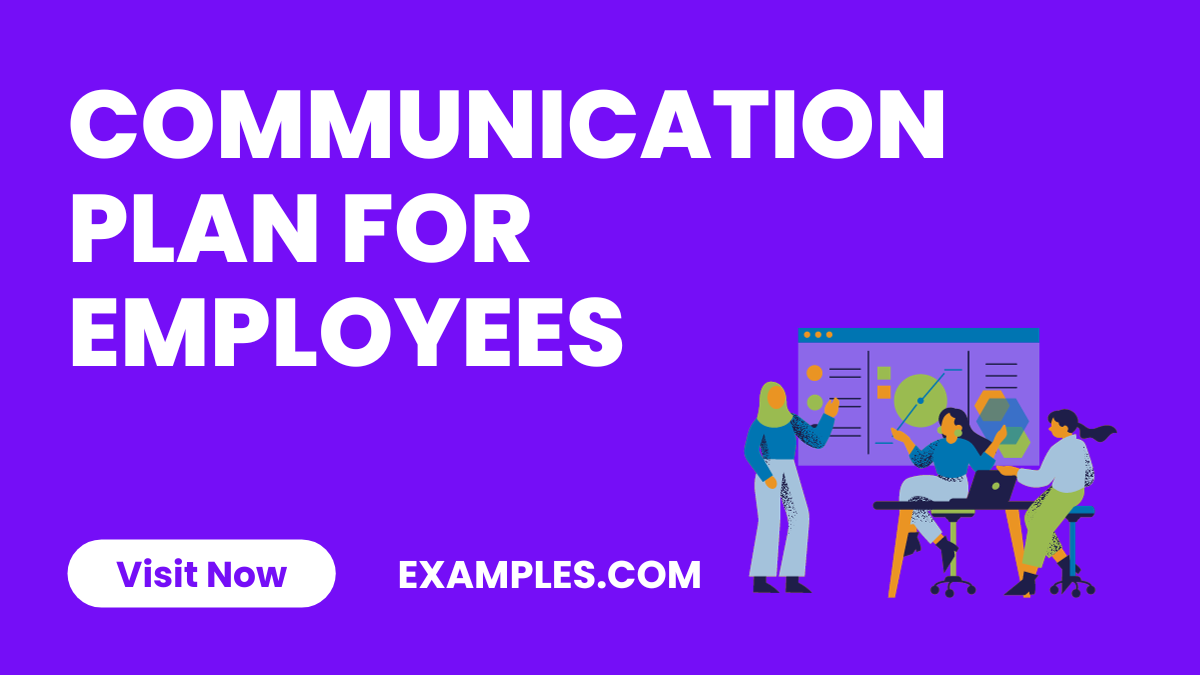
A comprehensive “Communication Plan for Employees” serves as the backbone of any thriving organization. This guide delves deep into effective communication examples, offering a rich array of strategies and insights. It’s tailored to enhance internal dialogue, ensuring clarity and cohesion across all levels. Discover how a well-crafted plan can revolutionize your team dynamics, boost morale, and streamline operations. By implementing these proven communication examples, you’ll foster a more engaged and productive workforce, paving the way for success.
Download Communication Plan for Employees Bundle
Communication Plan for Employees

The “Communication Plan for Employees”is a comprehensive guide designed to enhance team collaboration and productivity within an organization. It offers a structured approach with audience analysis, key messages, various communication channels, and an implementation strategy. The plan also includes regular evaluation and feedback mechanisms, emergency communication plan protocols, and annual reviews, supported by practical tools like templates and communication calendars. This guide is an essential resource for any organization looking to improve internal communication and foster a productive work environment
Internal Communication Plan for Employees

The document “Internal Communication Plan for Employees” is a structured approach for enhancing internal communication within organizations. It emphasizes the importance of clear and effective communication for improving teamwork and productivity. The plan includes targeting all employees across various departments and levels, key messages about company goals, policy changes, and employee recognition. It outlines diverse communication channels like email, instant messaging apps, internal newsletters, intranet, and meetings. The plan also covers implementation strategies, feedback mechanisms, training and support, evaluation methods, visual aids, and supporting documents, ensuring seamless, efficient, and effective internal communication plan within the organization
Hazard Communication Plan for Employees

The Hazard Communication Plan for Employees comprehensive guide to ensure workplace safety by informing employees about hazards and safety protocols. It covers key components like hazard identification, information dissemination, communication channels, emergency procedures, and regular training and drills. The plan also outlines an implementation strategy, documentation practices, evaluation and feedback mechanisms, and visual aids to support understanding. It’s designed to be straightforward, comprehensive, and ready for immediate implementation, emphasizing regular updates and active employee involvement.
Employee Survey Communication Plan

The Employee Survey Communication Plan is a provides a systematic approach to conducting surveys for honest feedback and employee engagement enhancement. It includes pre-survey communication, survey launch, mid-survey check-ins, post-survey communication, and results sharing, all aimed at identifying areas for improvement. The plan emphasizes clear messaging, regular updates, and visual aids like graphs and charts to track participation and evaluate communication effectiveness.
IT Employee Communication Plan Template
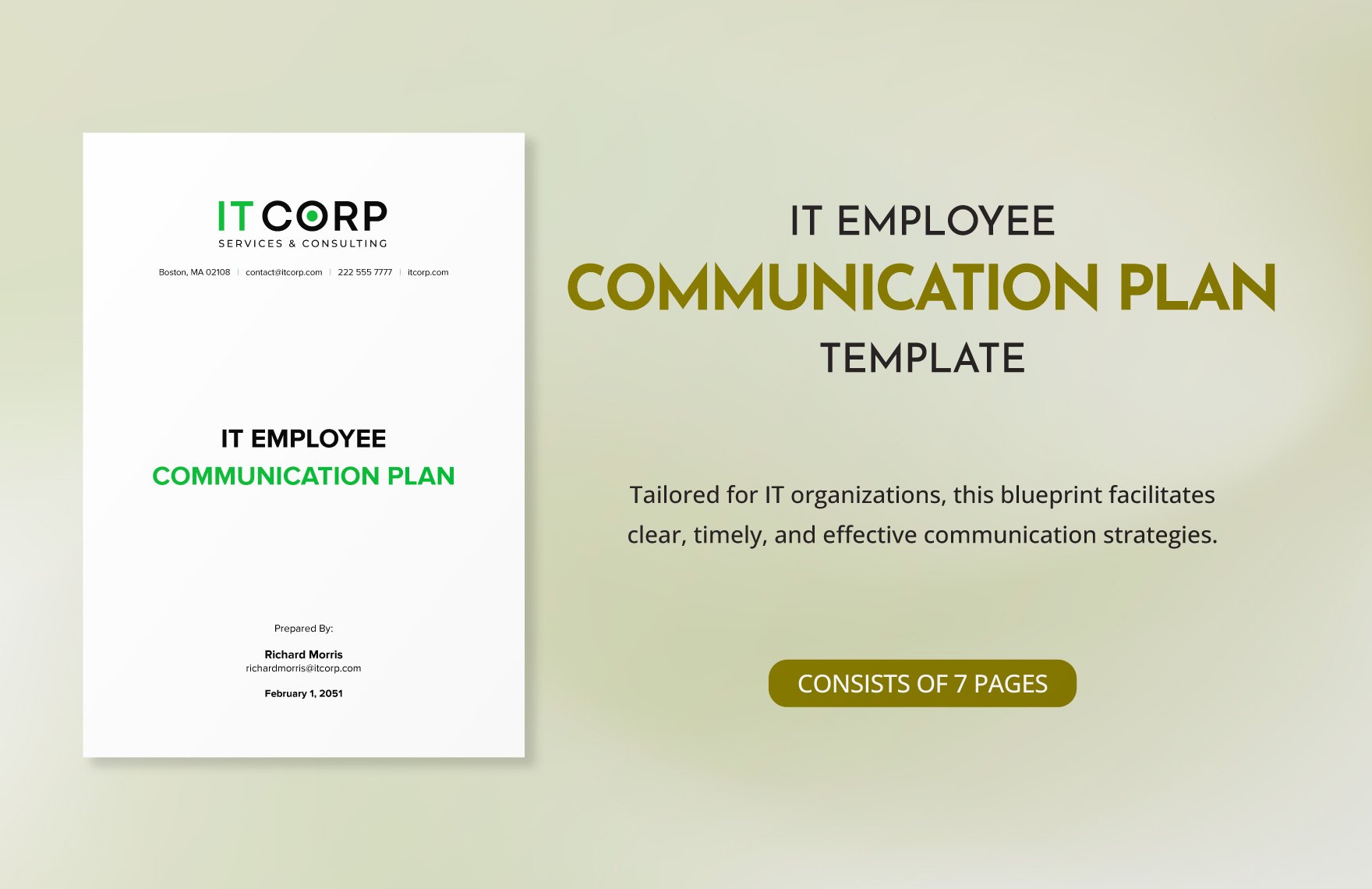
Employee Transition Communication Plan Template
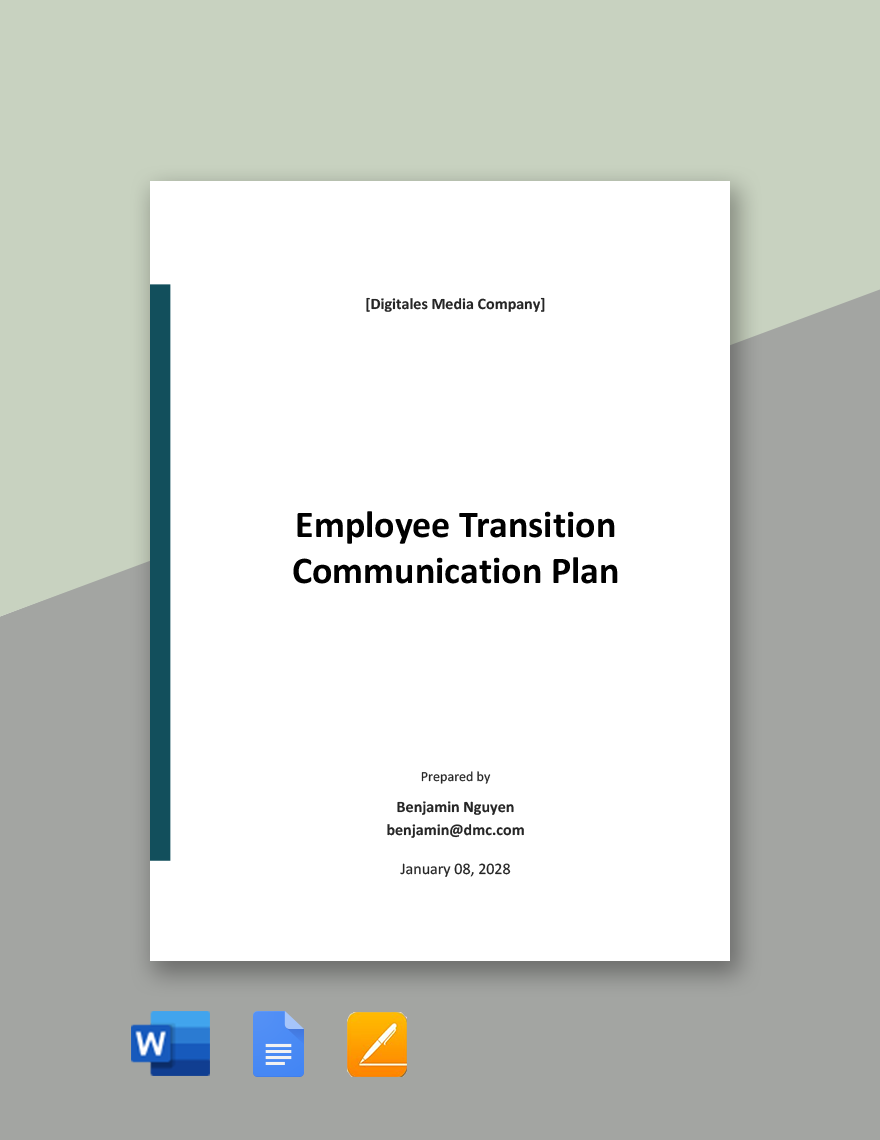
Employees Internal Communications Strategy template

intranetconnections.com
Communication Plan for Employees Checklist

cbiz.com
Ways To Build An Effective Employee Communication Plan
An effective Employee Communication Plan ensures a well-informed, engaged, and cohesive workforce. It’s crucial for establishing a shared understanding and achieving organizational goals. By integrating strategic methodologies and considering the diverse communication needs of your employees, you can develop a plan that promotes transparency, productivity, and a positive work culture.
Regular Team Meetings: Schedule weekly or bi-weekly meetings to discuss ongoing projects and address concerns.
Let’s gather to align our goals and share updates every Monday morning.
Employee Surveys: Conduct surveys to gather feedback on workplace satisfaction and communication effectiveness.
Your input is valuable; please fill out this survey to help us improve our communication.
Email Newsletters: Send out a monthly newsletter to keep employees informed about company news and achievements.
Check out our latest newsletter for important updates and employee spotlights!
Suggestion Box: Encourage open communication by allowing employees to anonymously submit suggestions and ideas.
Feel free to drop your suggestions in the box; every idea is welcome!
Training Sessions: Offer regular training to help employees improve their communication skills and understand the plan.
Join our communication skills workshop to enhance your team collaboration.
Digital Notice Boards: Utilize digital boards for instant updates and reminders.
Keep an eye on the digital board for the latest news and updates.
One-on-One Check-ins: Personal meetings between managers and employees to discuss progress and concerns.
Let’s schedule a check-in to discuss your progress and any support you might need.
Collaborative Tools: Implement tools like Slack or Teams for easy day-to-day communication and project coordination.
Please update the team on your project status in our Slack channel.
Feedback Culture: Promote a culture where constructive feedback is encouraged and valued.
We appreciate your feedback; let’s discuss how we can implement your suggestions.
Transparent Leadership: Ensure leaders communicate openly about changes and decisions.
We want to be transparent about the upcoming changes and how they will affect you
How to Write Communication Plan for Employees?
Writing a comprehensive Communication Plan for Employees involves strategic planning and clear objectives to ensure effective internal communication.
Define Objectives: Establish what you aim to achieve with the communication plan, like improved transparency or enhanced team collaboration.
Identify the Audience: Understand your employees’ roles, departments, and communication needs.
Develop Key Messages: Tailor messages that resonate with your employees, focusing on clarity and relevance to their roles.
Choose Appropriate Channels: Select the most effective communication tools, whether it’s email, internal newsletters, or team meetings.
Set a Timeline: Define the frequency of communications, like weekly updates or monthly newsletters.
Assign Responsibilities: Designate team members to handle different aspects of communication, ensuring accountability.
Establish Feedback Mechanisms: Incorporate systems for employees to provide feedback on communications.
Review and Adapt: Regularly assess the effectiveness of your communication plan and make necessary adjustments.
Ideas for Communication Plan for Employees
A robust “Communication Plan for Employees” fosters a harmonious and productive workplace. It’s crucial for ensuring everyone is aligned with the organization’s goals and feels valued. Explore these unique and effective ideas designed to enhance internal communication, increase engagement, and build a stronger team dynamic.
Monthly Town Halls:
Explanation: A forum for management to share updates and employees to voice concerns.
How to Communicate: “Join us for our monthly town hall to discuss upcoming projects and provide your valuable feedback.”
Suggestion Box:
Explanation: An anonymous way for employees to contribute ideas for improvement.
How to Communicate: “Drop your innovative ideas or concerns in the suggestion box; your voice matters to us.”
Peer-to-Peer Recognition Program:
Explanation: Employees acknowledge each other’s achievements, fostering a positive culture.
How to Communicate: “Congratulations to John for exceptional customer service this month, nominated by his peers.”
Departmental Newsletters:
Explanation: Regular updates specific to each department’s activities and achievements.
How to Communicate: “Check out the latest edition of the Finance Department newsletter for key updates and team highlights.”
Training Webinars:
Explanation: Online sessions to enhance skills and knowledge.
How to Communicate: “Register for next week’s webinar on effective communication skills tailored for our team.”
Employee Surveys:
Explanation: Collect feedback on various aspects of workplace culture and communication.
How to Communicate: “Your opinion is crucial; please fill out this quick survey to help us improve.”
Team Building Activities:
Explanation: Regular activities designed to strengthen relationships and improve collaboration.
How to Communicate: “Join us for a team-building retreat this Friday to connect and unwind together.”
Weekly Round-Up Emails:
Explanation: A summary of the week’s important news, updates, and achievements.
How to Communicate: “Catch up on this week’s highlights and updates in our weekly round-up email.”
Dedicated Intranet Forums:
Explanation: Online platforms for discussing projects, sharing ideas, and asking questions.
How to Communicate: “Have a question or idea? Post it on the intranet forum and collaborate with your colleagues.”
Interactive Q&A Sessions:
Explanation: Live sessions where employees can ask questions directly to leadership.
How to Communicate: “Participate in our next Q&A session and get direct answers from the management team.”
How To Effectively Communicate Your Strategic Plan To Employees?
Effective communication is the cornerstone of ensuring your strategic plan not only resonates with your employees but also translates into action. This guide provides a detailed roadmap to help you convey your strategic plan effectively to your team, optimizing for “Communication Plan for Employees.”
Understand Your Audience
Objective: Before communicating your plan, understand the diverse needs and perspectives of your employees.
Conduct Surveys: Understand employee sentiments, concerns, and suggestions.
Segment Audience: Tailor your message for different departments, roles, and levels of seniority.
Clarify Your Vision and Objectives
Objective: Clearly articulate what the strategic plan is, why it’s important, and the role employees play in its success.
Simplify the Message: Use clear, jargon-free language.
Highlight Benefits: Explain how the plan benefits the organization and employees.
Choose the Right Communication Channels
Objective: Use the most effective channels to reach all employees.
Mix of Channels: Use emails, meetings, newsletters, and intranet posts.
Interactive Sessions: Host Q&A sessions, workshops, and webinars for deeper engagement.
Create a Detailed Rollout Schedule
Objective: Ensure a structured and phased approach to communication.
Initial Announcement: Outline the plan’s purpose, scope, and importance.
Ongoing Engagement: Regular updates, stories of progress, and acknowledgments of employee contributions.
Encourage Two-Way Communication
Objective: Foster an environment where employees feel heard and valued.
Feedback Mechanisms: Surveys, suggestion boxes, and forums.
Open Door Policy: Encourage employees to discuss the plan directly with management.
Train Your Leaders
Objective: Equip leaders at all levels to communicate and champion the plan effectively.
Training Sessions: Educate leaders on the plan’s details and their role in its communication.
Empowerment: Encourage leaders to personalize the message for their teams.
Monitor and Adapt
Objective: Continuously gauge the effectiveness of your communication and adapt as needed.
Track Engagement: Use metrics like open rates, attendance, and feedback.
Be Flexible: Adjust the strategy based on what’s working and what’s not.
Reinforce with Visual Aids and Storytelling
Objective: Make the strategic plan relatable and memorable.
Infographics and Videos: Visual summaries of the plan and progress.
Success Stories: Share how changes are positively impacting the team and organization.
Follow-Up and Feedback
Objective: Ensure the message is understood and gather insights for improvement.
Follow-Up Meetings: Discuss the plan’s progress and address any concerns.
Continuous Feedback: Regularly solicit employee feedback to improve future communications.
The USC Annenberg School for Communication and Journalism’s article underscores the importance of effective communication in ensuring business strategies are understood and executed. It highlights the role of engaged employees in driving ROI and the low engagement rates among American workers. Employers are encouraged to employ various tactics such as surveys, training, and events to ensure employees are aligned with the company’s core values and strategy. Additionally, it notes the importance of targeting messaging for external stakeholders through consistent marketing and social media engagement.
The article “How to Develop an Internal Communication Strategy” importance of internal communication in fostering a collaborative and productive work environment. It highlights that while companies invest heavily in external marketing, internal communication is often overlooked, leading to disengagement among employees. Effective internal communication is not just about disseminating information but also about building relationships and understanding employee motivations. This approach can significantly enhance employee retention and productivity, contributing to a more connected and engaged workforce.


